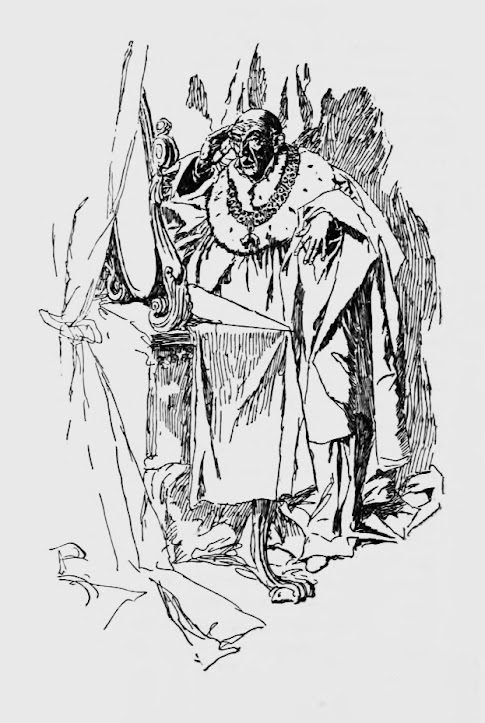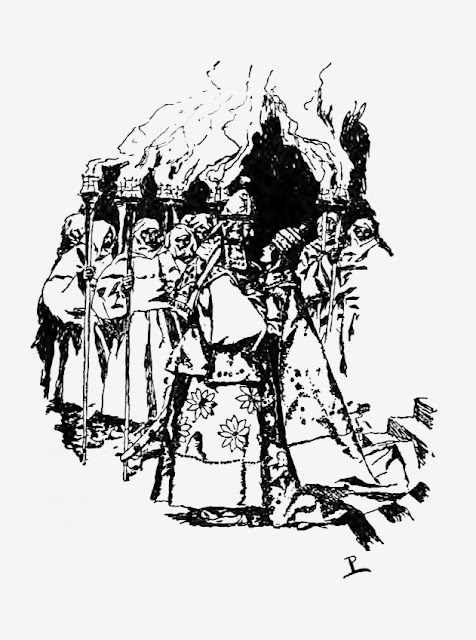Howard Pyle (1853, Wilmington Del. - 1911, Florence) was one of America’s most popular illustrators and storytellers at the end of the 19th century during a period of explosive growth in the publishing industry. His illustrations appeared in magazines like Harper’s Monthly, St. Nicholas, and Scribner’s Magazine, gaining him both national and international exposure. The broad appeal of his imagery made him a celebrity in his lifetime.
Pyle studied at the Art Student’s League, New York City, and first attracted attention by his line drawings after the style of Albrecht Dürer. His magazine and book illustrations are among the finest of the turn-of-the-century period in the Art Nouveau style. Pyle wrote original children’s stories as well as retelling old fairy tales. Many of Pyle’s children’s stories, illustrated by the author with vividness and historical accuracy, have become classics—most notably The Merry Adventures of Robin Hood (1883); Otto of the Silver Hand (1888); Jack Ballister’s Fortunes (1895); and his own folktales, Pepper & Salt (1886), The Wonder Clock (1888), and The Garden Behind the Moon (1895).
In 1894, he began teaching illustration at the Drexel Institute of Art, Science, and Industry. Among his students there wer valet Oakley, Maxfield Parrish, and Jessie Wikcox Smith. After 1900, he founded his own school of art and illustration named the Howard Pyle School of Illustration Art. Scholar Henry C. Pitz later used the term Brandywine School for the illustration artists and Wyeth family artists of the Brandywine region, several of whom had studied with Pyle. He had a lasting influence on a number of artists who became notable in their own right; N.C. Wyeth, Frank Schoonover, Thornton Oakley, Allen Tupper True, Stanley Arthur, and numerous others studied under him.
Later Pyle undertook mural paintings, executing, among others, The Battle of Nashville (1906) for the capitol at St. Paul, Minn. Dissatisfied with his style in painting, he went to Italy for further study but died shortly afterward. Pyle had established a free schoolof art in his home in Wilmington, where many successful American illustrators received their education.
Pyle travelled to Florence, Italy in 1910 to study mural painting. He died there in 1911 of a sudden kidney infection (Bright’s Disease).
For earlier works by Howard Pyle see parts 1-7 also.
This is part 8 of a 13-part series on the works of Howard Pyle:
1896 Twilight Land by Howard Pyle:
 |
| 1897 The Battle of Bunker Hill Scribner's Magazine November 8 1897 |
 |
| 1897 The Return from Deerfield for "A Half-Century of Conflict" Little Brown and Co. |
 |
| 1898 Headpiece for 'Good for the Soul' |
 |
| 1898 Old Captain Harper's Monthly December 1898 |
 |
| 1898 Old Chester Tales Harper's Monthly, October 1898 |
 |
| 1898 The Attack Upon the Chew House oil on canvas 59 x 89.5 cm Delaware Art Museum |
 |
| 1898 Thomas Jefferson writing the Declaration of Independence wood engraving 17.1 x 11.2 cm ( image ) Fine Arts Museums of San Francisco, CA |
 |
| 1898 ‘And who's going to support 'em?' demanded Mrs. Barkley oil on cardboard Private Collection |
 |
| 1898 “I had enemies in my line” Harper's Monthly, October 1898 |














































No comments:
Post a Comment
Note: only a member of this blog may post a comment.